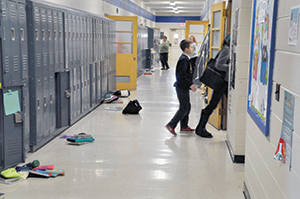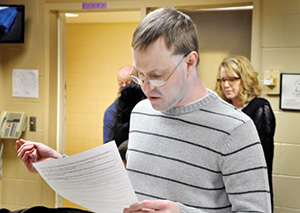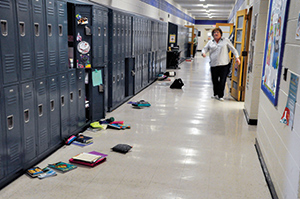In 2013, “growing pains” prompted staff at St. Alphonsus School in Greendale to reassess their level of emergency preparedness, especially in regards to severe weather.
 During the drill, the last of the students head into a science lab. The school’s goal was to complete the drill in under 15 seconds; they did it in less than half that time.In November, after a two-year process that included a complete overhaul of several of its crisis management protocols, the school was given StormReady status by the National Weather Service, a recognition that reflects the school’s compliance with the most stringent preparedness guidelines.
During the drill, the last of the students head into a science lab. The school’s goal was to complete the drill in under 15 seconds; they did it in less than half that time.In November, after a two-year process that included a complete overhaul of several of its crisis management protocols, the school was given StormReady status by the National Weather Service, a recognition that reflects the school’s compliance with the most stringent preparedness guidelines.
According to St. Alphonsus safety coordinator Tim Lethlean, two instances in particular highlighted the need for a reevaluation of the school’s severe weather preparation plans.
One was an unsatisfactory tornado drill in 2012.
“We ran the drill and there were classes that didn’t even make it down to the first floor; they got caught in the stairs. We had kids taking shelter in hallways that had windows lining them,” said Lethlean. “I think everybody had kind of taken that plan for granted and then when we actually ran a test of it, we went, ‘Wow, we need to put some effort behind this.’”
Another event served to drive that point home – a very real tornado warning in November 2013 came on a Sunday morning, finding the classrooms full of volunteer catechists and Christian formation classes confused about what to do.
“They had to follow the real procedures and get down to the first floor and take shelter there, and as a result of that, a number of questions came up of, OK, once I get the kids down there, what do I do? How do I get information? What communications are in place?” said Lethlean, who works fulltime as an IT project manager with a local manufacturing company. “We had a lot of questions we didn’t have answers to.”
“We knew it was time for a higher-level look at the entire crisis plan,” said principal Pat Wadzinski in an email to the Catholic Herald. “We investigated and found root causes that can be largely classified as growing pains. They included confusion with bell/horn signals (our ancient fire alarm had been recently updated and replaced) and muddled conflict in hallway traffic routes (as the building had been recently reorganized as enrollment increased).”
To fix the problems, Lethlean, Wadzinski and the St. Alphonsus’ Safety Committee pursued certification for the school  Tim Lethlean reviews details of the severe weather drill with staff at St. Alphonsus School, Greendale, Nov. 17.through the National Weather Service’s StormReady program. The program “was designed to be a guideline for schools and other entities to strive for updating their hazardous weather plans, to figure out what kind of information they need to be getting and giving out to people, either in their communities or schools,” said Tim Halbach, Warning Coordination Meteorologist for the local National Weather Service office.
Tim Lethlean reviews details of the severe weather drill with staff at St. Alphonsus School, Greendale, Nov. 17.through the National Weather Service’s StormReady program. The program “was designed to be a guideline for schools and other entities to strive for updating their hazardous weather plans, to figure out what kind of information they need to be getting and giving out to people, either in their communities or schools,” said Tim Halbach, Warning Coordination Meteorologist for the local National Weather Service office.
For St. Alphonsus, this included updating how they received severe weather warnings and communicated that information throughout the school. Instead of using an outdated bell system, the school installed automation that takes over the PA system at the threat of severe weather, informing the building’s occupants of exactly where to take shelter and even on which sides of the hallway to walk.
Lethlean also had to painstakingly plot out each class’ route to its safe shelter space, to avoid snafus like the 2012 drill.
“We had to really plot out, for each classroom, exactly which stairwell they go down in order to make sure we didn’t have logjams. We had an awful lot of traffic issues in the stairway. The weather service wants everyone downstairs within two to three minutes. That’s a tough thing to do,” he said. “Now, when we run the procedure, we’re hitting the three minute mark.”
The school has also committed to running more frequent and realistic drills.
“I think if you go back three or four years, we were guilty of being one of the schools that, every time we ran a drill, all the kids were sitting in homeroom – it was kind of unrealistic,” said Lethlean. “We really changed that mindset in the past two or three years. This last drill that we ran, we actually had three grade levels that were outside at recess, and we did that intentionally. The more that we try different circumstances and just try to be more realistic in our circumstances, the more confident the staff feels.”
The National Weather Service also consulted on ideas to improve the safety features in the building’s basement, which Lethlean says the safety committee is hoping to implement.
Halbach visited St. Alphonsus on Nov. 17 to observe a drill and present the school with its StormReady certification.
“Everything that they had done was exemplary; it was an easy thumbs-up to give them the StormReady certification,” he said.
 Science teacher Linda Sokup checks the corridor to make sure all students are out of harm’s way. Upon completion of the drill the school recieved StormReady certification from the National Weather Service (Catholic Herald photos by John Kimpel)Halbach encourages other school administrators, business owners and even city governments to consider pursuing StormReady certification. Other entities that have achieved the recognition include Shorewood School District, Miller Park and the WISN-12 studios in Milwaukee.
Science teacher Linda Sokup checks the corridor to make sure all students are out of harm’s way. Upon completion of the drill the school recieved StormReady certification from the National Weather Service (Catholic Herald photos by John Kimpel)Halbach encourages other school administrators, business owners and even city governments to consider pursuing StormReady certification. Other entities that have achieved the recognition include Shorewood School District, Miller Park and the WISN-12 studios in Milwaukee.
“Severe weather does occur during the school year. Especially if there’s any kind of special activities going into the evening (it’s important to prepare),” said Halbach. “It might not be frequent, but we do get severe weather, tornadoes and all that here in southern Wisconsin. So it’s a very important thing to deal with.
“People that have gone into this … may think initially that their plans are OK but they will sometimes realize that there are some things that they’re missing, or some things they didn’t understand.”
Lethlean, also the father of Olivia, a second grader, and Christian, a first grader, at the school, will rest easier now that St. Alphonsus has been deemed StormReady. He has served the school on a volunteer basis for five years, taking vacation time every month to devote to maintaining the safety protocols at St. Alphonsus, and he considers it time well spent.
“Safety procedures in schools were static for many, many years. If you could pull the fire alarm and get out in two minutes and 30 seconds, you’re good,” he said. “There’s so much guidance now that … honestly, every time I work with a different entity and find out what they’re doing (for emergency preparedness), there’s information coming in of, oh wow, should we tweak?”
“We aren’t out to frighten children but we do what to ensure our procedures work. Given the variety of threats educational environments face today, our parents are very appreciative of safety and crisis planning efforts including the StormReady certification process,” said Wadzinski. “I have received ‘thank yous’ from parents – especially law enforcement and first responders who realize the importance of preparedness.”
